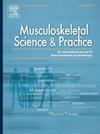管理非创伤性青少年膝关节疼痛:在二级护理中使用map -膝关节工具的可行性
IF 2.2
3区 医学
Q1 REHABILITATION
引用次数: 0
摘要
最近开发了一种临床决策支持工具(MAP-Knee tool),用于支持临床医生和患有非外伤性膝关节疼痛的青少年之间的咨询过程,并在减少诊断不确定性的同时加强共同决策。目的:我们旨在评估在骨科使用MAP-Knee Tool治疗青少年非外伤性膝关节疼痛的可行性。DesignFeasibility研究。方法采用访谈、问卷调查和对两位骨科医生的观察相结合的方法。可行性评估基于可接受性(从“非常可接受”到“非常不可接受”的7分等级量表分为“可接受”(6-7类)或“不可接受”(1-5类),适当性(时间消耗),保真度(工具是否按预期使用和转诊模式)和可持续性(外科医生是否会继续使用该工具)。年龄在10-19岁的非外伤性膝关节疼痛青少年的咨询符合纳入条件。结果纳入16例咨询。每次会诊的时间在8到20分钟之间,符合外科医生通常会诊的时间框架。两位外科医生都认为该工具“非常可接受”。他们推荐了9名青少年进行治疗,4名进行诊断成像,3名没有接受进一步治疗或转诊,外科医生表示该工具不影响他们的转诊。外科医生表示,该工具适用于他们的情况,他们会特别推荐给年轻的医生。结论基于骨科医生在青少年会诊时使用MAP-Knee Tool的经验,MAP-Knee Tool在二级医疗中是可行的。本文章由计算机程序翻译,如有差异,请以英文原文为准。
Managing non-traumatic Adolescent knee Pain: feasibility of using the MAP-Knee Tool in secondary care
Background
A clinical decision-support tool (MAP-Knee Tool) was recently developed to support the consultation process between clinicians and adolescents with non-traumatic knee pain and enhance shared decision-making while reducing diagnostic uncertainty.
Objectives
We aimed to assess the feasibility of using the MAP-Knee Tool in an orthopaedic department for adolescents consulting with non-traumatic knee pain.
Design
Feasibility study.
Method
We combined interviews, a questionnaire, and observations of two orthopaedic surgeons. Feasibility was evaluated based on Acceptability (dichotomised to 'acceptable' (categories 6–7) or 'unacceptable' (categories 1–5) from a 7-point rank scale ranging from 'very acceptable' to 'very unacceptable'), Appropriateness (time consumption), Fidelity (whether the tool was used as intended and the referral pattern), and Sustainability (whether surgeons would continue to use the tool). Consultations with adolescents aged 10–19 years with non-traumatic knee pain were eligible for inclusion.
Results
We included 16 consultations. The duration of each consultation ranged between 8 and 20 min, which fit within the time frame of the surgeons' usual consultations. Both surgeons rated the tool as “very acceptable”. They referred nine adolescents for treatment, four for diagnostic imaging, and three did not receive further treatment or referrals, and the surgeons expressed that the tool did not affect their referral. The surgeons stated that the tool was applicable to practice within their context and that they would especially recommend it to younger doctors.
Conclusions
The MAP-Knee Tool is feasible to use in secondary care based on the experiences of orthopaedic surgeons using the tool during consultations with adolescents.
求助全文
通过发布文献求助,成功后即可免费获取论文全文。
去求助
来源期刊

Musculoskeletal Science and Practice
Health Professions-Physical Therapy, Sports Therapy and Rehabilitation
CiteScore
4.10
自引率
8.70%
发文量
152
审稿时长
48 days
期刊介绍:
Musculoskeletal Science & Practice, international journal of musculoskeletal physiotherapy, is a peer-reviewed international journal (previously Manual Therapy), publishing high quality original research, review and Masterclass articles that contribute to improving the clinical understanding of appropriate care processes for musculoskeletal disorders. The journal publishes articles that influence or add to the body of evidence on diagnostic and therapeutic processes, patient centered care, guidelines for musculoskeletal therapeutics and theoretical models that support developments in assessment, diagnosis, clinical reasoning and interventions.
 求助内容:
求助内容: 应助结果提醒方式:
应助结果提醒方式:


